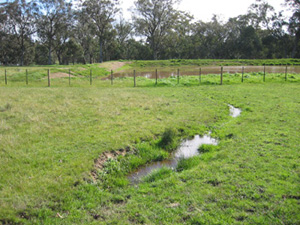Contamination of waters by organic matter including manures is a type of water pollution. Excessive organic matter load in water is likely to cause a number of changes including:
Higher turbidity
High decomposition rate leading to elevated carbon dioxide and lowered oxygen,
Undesirable intermediate products of decomposition including nitrite and ammonia.
Elevated nutrient levels
Elevated dissolved organic matter
Elevated bacteria levels in general and specifically E coli if manures are present
The owner of this dam on a property north of Melbourne noticed an unpleasant smell coming from the dam. The water was also very discoloured.

Here are the test results for this dam: pH 6.8, ORP 217 mV (low end of desirable range), turbidity 624 FTU (very turbid), UV absorbance 40% at 1 : 25 dilution (very high), ammonia + ammonium 12.4 mg/L (high), carbon dioxide (dissociated fraction) 25.6 ppm (high), nitrate 8.9 mg/L (slightly elevated), nitrite 0.16 mg/L (any nitrite is undesirable), phosphate 16.9 mg/L (very high), E coli 13,100 CFU’s / 100 mls (very high), aerobic plate count 2,067,000 CFU’s / 100 mls (high).The indications are that there is an organic matter contamination problem – because of the E coli, probably from manure.
Here are the results from the drain in the foreground of the photo: pH 6.9, ORP -33 mV (very low, indicates low or depleted oxygen)), turbidity 976 FTU (very high levels of semi suspended particles), UV absorption 53% (high, at 1 : 25 dilution), ammonia 26.3 mg/L (high), carbon dioxide 42 ppm, nitrate and nitrite both 0, phosphate 27.3 mg/L (very high), E coli 14,900 CFU’s / 100 ml, aerobic plate count 1,553,000 CFU’s / 100 ml.
My brief interpretation: Decomposition in the runoff water is producing ammonia and carbon dioxide. As the water reaches the dam oxygenation levels increase slightly allowing some nitrate to be produced. However there is not enough oxygen to convert all the nitrogen decomposition products to nitrate hence there is some nitrite detectable in the water.